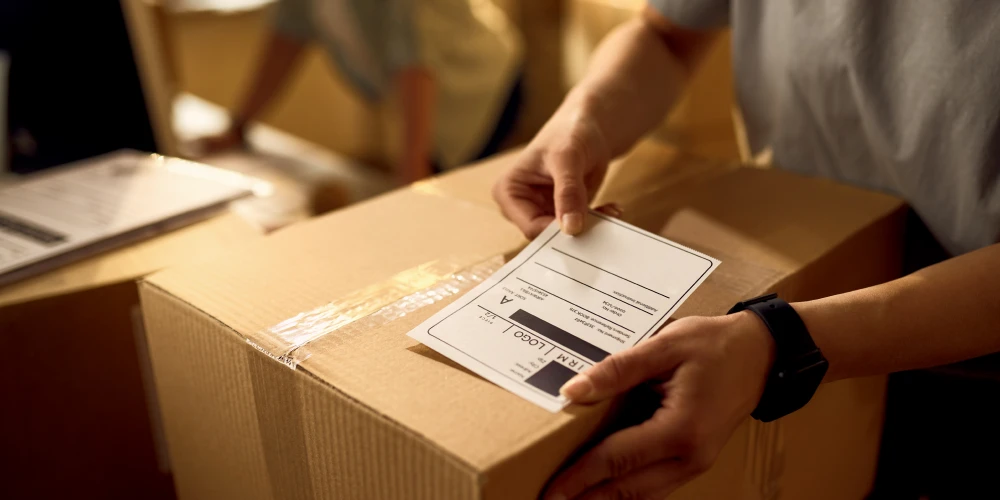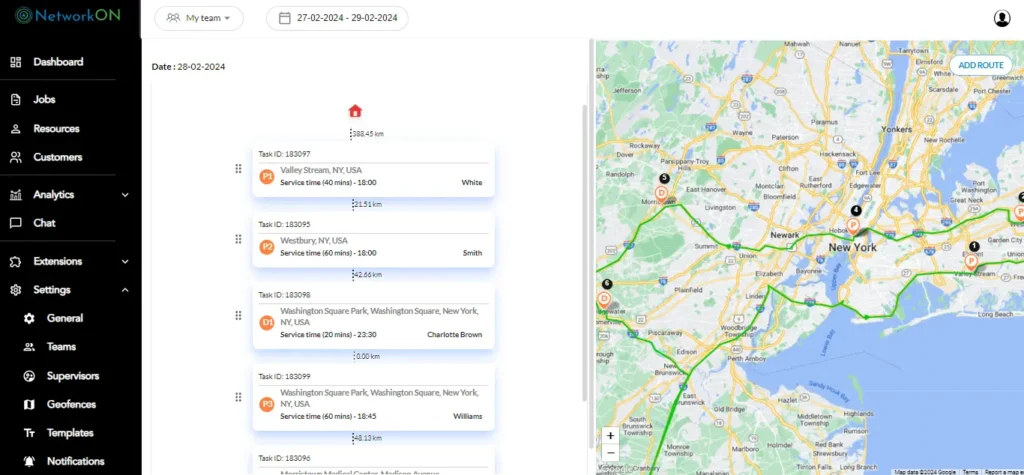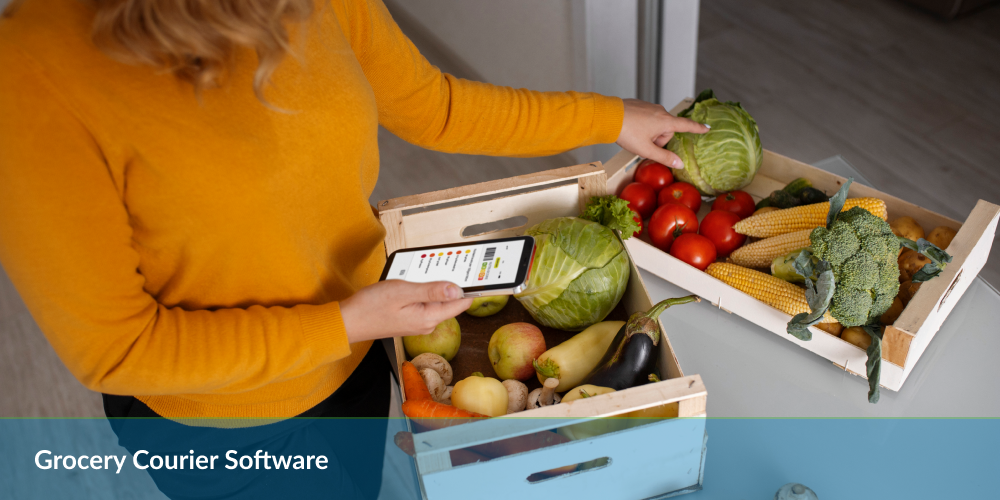Table of Contents
Welcome to the digital era, where e-commerce delivery platforms are the linchpin in online retail architecture. These sophisticated systems are the backbone of distribution for retailers and businesses, shaping the fulfillment landscape with precision and efficiency.
A delivery platform in e-commerce is a tool and a transformative force, streamlining the intricate dance of moving products from warehouse shelves to customers’ doorsteps. By harnessing this technology, businesses enhance their operational capabilities and deliver exceptional service, elevating the customer experience to new heights.

An e-commerce delivery platform revolutionizes how businesses engage with customers, particularly in retail. By streamlining the business process, such platforms enhance order fulfillment and workflow management, ensuring efficient handling of purchase orders and risk management. Strategic partnerships with corporations optimize distribution, enabling swift shipping of products to consumers.
This seamless integration extends beyond typical goods, encompassing sectors like food and tourism, thereby broadening market reach. Effective customer service and control management tools are essential in maintaining schedules and ensuring customer satisfaction. Proposals for such platforms often emphasize cost savings, improved product availability, and the robustness of online shopping infrastructure, promising significant benefits for businesses and end consumers.
Navigate the labyrinth of orders, logistics, and timelines with the seamless integration provided by today’s top-tier e-commerce delivery platforms.
Streamlining Order Fulfillment
Seamless order processing is the heart of thriving e-commerce businesses. With digital retail competition at an all-time high, efficient order handling differentiates top market players from the rest. Swift and error-free order fulfillment is not simply a target but a benchmark for running an online store.
Customers consistently reward reliable and prompt delivery merchants with loyalty and positive reviews. The velocity at which items move from shopping cart to delivery impacts customer satisfaction directly. Additionally, the intricacy of logistics operations substantially decreases when orders flow smoothly from inception to completion.
Third-party logistics (3PL) providers responsible for the warehousing, picking, packing, and shipping of goods gain immensely from a robust e-commerce delivery platform. Such a solution not only diminishes human error but also enhances the speed of warehouse operations. A platform integrated with order management systems facilitates a synergetic workflow, permitting a faster turnaround of goods dispatched.
Last-Mile Delivery Optimization
The final leg of delivery, commonly known as the last mile, is a significant phase in the e-commerce delivery platform. Efficiency at this stage directly correlates to customer satisfaction and cost management. Identifying challenges and implementing effective solutions ensures a streamlined process.
Challenges and Solutions in Last-Mile Delivery
High costs, unpredictable delays, and customer availability for delivery constitute some of the primary hurdles within last-mile logistics. A solution to these issues lies in adopting dynamic routing and scheduling software, which adjusts real-time delivery routes to account for traffic and other unforeseen delays. Additionally, leveraging local distribution centers can minimize the distance to the customer, thus reducing costs.
Strategies for Third-Party Logistics Providers
- Adopting Technology: 3PLs can introduce GPS-enabled vehicles for real-time tracking and drones for small package deliveries to overcome last-mile challenges.
- Data Analytics: Analyzing delivery data helps predict the best routes and times, leading to fewer failed delivery attempts.
- Partnering Locally: By partnering with local businesses for package pick-up points, 3PLs offer flexibility to consumers, further enhancing the delivery experience.
These strategies address the immediate challenges and bolster 3PLs’ capabilities to meet evolving demands.
Seamless Sales Channel Integration in E-commerce Delivery Platforms
Successful retailers understand the value of omnichannel selling. E-commerce delivery platforms underpin their success by offering robust integration with various sales channels, including online marketplaces, social media platforms, and brick-and-mortar POS systems.
Connecting Multiple Sales Outlets with a Single Delivery Solution
Retailers that utilize integrated delivery platforms can easily manage orders from multiple channels. By centralizing the logistics process, these platforms enable retailers to ensure consistency in customer experience, streamline inventory management, and expedite order processing.
Illustrations of this range from large retail brands with a presence on multiple online storefronts to small businesses looking to scale operations. These platforms typically feature plug-and-play integrations with popular e-commerce frameworks and marketplaces like Amazon and eBay.
Real-Time Package Tracking
Customers expect instantaneous information regarding their orders. Real-time package tracking satisfies this demand by providing updates at every stage of the delivery process. Tracking solutions integrate technology to keep consumers informed, enhancing transparency and trust.

Technology Solutions for Tracking and Communication
Advanced technology underpins effective package tracking systems. GPS technology, RFID tags, and mobile apps work in tandem to relay package locations to customers and businesses alike. With these tools, delivery platforms offer instant access to tracking data, ensuring that the sender and recipient remain up-to-date on parcel whereabouts. Furthermore, push notifications and text messages inform customers of status changes, providing a seamless flow of communication.
- GPS technology pinpoints the exact location of a package.
- RFID tags allow quick scanning and status updates as parcels move through various checkpoints.
- Mobile applications facilitate direct customer access to tracking information and notifications.
Integration of these technologies into e-commerce delivery platforms bridges the gap between physical logistics and digital convenience. By offering real-time visibility, businesses foster a reliable delivery experience, which can be a decisive factor in customer retention and brand loyalty.
Automated Shipping and Returns Management
Automation transforms the efficiency and reliability of shipping and returns within the e-commerce sphere. By deploying automated systems, companies achieve expedited fulfillment cycles, minimize human error, and enhance the overall quality of customer service. Not prioritizing this component of an e-commerce delivery platform can lead to lost sales and a tarnished brand reputation; hence, businesses leverage sophisticated software to navigate these operations precisely.
The integration of automation not only accelerates processes but also meticulously balances speed, cost containment, and customer satisfaction. Automated shipping solutions provide businesses with tools to process orders swiftly, print shipping labels, and schedule pickups without manual intervention. Similarly, managing returns becomes less labor-intensive as returns processing platforms automatically generate return labels, guide customers through the process, and update inventory upon receiving the returned goods.
Benefits of Advanced Automation in Dispatch and Reverse Logistics
- Efficient Order Routing: Algorithms determine the most cost-effective shipping methods and routes while maintaining desired delivery times.
- Carrier Integration: Direct linkage with many carriers ensures that orders are dispatched with the most suitable carrier without manual selection.
- Smart Return Labels: Customer-friendly options for returns are created with pre-filled information, further streamlining the process.
- Detailed Analytics: Insights into shipping and returns trends offer the ability to refine logistics strategies continuously.
A fully automated returns management system will effectively handle increased volume without additional stress on resources, responding in real-time to customer demands. This agility is particularly vital during peak seasons and promotional periods.
Preparation meets opportunity when businesses approach peak seasons and sales with the right e-commerce delivery platform. Fluctuations are a given, yet these platforms are designed to rise to the challenge, effortlessly accommodating spikes in order volume.
An e-commerce delivery platform offers critical support for scalability and flexibility, enabling merchants to expand their operations seamlessly. Advanced systems handle increased transactions without sacrificing speed or accuracy.
- Scalable infrastructure adapts in real-time, aligning with the market’s changing demands.
- Flexible resource allocation allows for rapid adjustment in logistics capabilities, ensuring that businesses can capitalize on increased demand without delaying deliveries.
- Dynamic scaling mechanisms maintain performance by balancing loads and redistributing resources during traffic surges.
Peak periods do not simply challenge the capacity. They also test the efficiency of integration protocols with warehouses, inventory systems, and transportation models. The right platform transforms these high-pressure times into opportunities for growth, leveraging smart technology to keep operations poised for success.
Maximize Efficiency with Advanced Warehouse Management Systems
Success in an e-commerce delivery platform hinges on seamless integration with Warehouse Management Systems (WMS). This synergy powers the entire order fulfillment process, ensuring products move swiftly from storage shelves to customers’ doorsteps. A sophisticated WMS brings precision to inventory management, streamlining warehouse operations and aligning them closely with order processing and delivery rhythms.
Streamlined End-to-End Operations Through WMS Integration
WMS integration with an e-commerce delivery platform ensures an uninterrupted flow of data. As orders are received, the delivery platform communicates directly with the WMS, triggering the picking, packing, and shipping processes. This results in reduced lead times and a higher accuracy rate in order fulfillment, directly benefitting customer satisfaction.
Key Features of a Warehouse Management System
A high-caliber WMS boasts a suite of features designed to complement a robust delivery platform:
- Real-Time Inventory Tracking: Maintains an up-to-the-minute record of stock levels, reducing the risk of overselling and stockouts.
- Optimized Picking Paths: Calculated routes within the warehouse reduce wasted time and effort, expediting the fulfillment process.
- Automated Replenishment: Automatically signals when inventory is low, prompting reorder processes and maintaining optimal stock levels.
- Barcode Scanning: Minimizes picking, packing, and shipping errors by validating products against order details.
- Detailed Reporting and Analytics: Generates actionable insights into warehouse operations, contributing to continuous improvement.
Integrating these WMS features into an e-commerce delivery platform not only sharpens inventory accuracy but also fortifies the efficiency of the entire supply chain.
Cross-Border e-commerce Logistics
The landscape of international shipping and customs presents a tapestry of regulations and requirements that vary by destination. Successfully navigating cross-border e-commerce logistics hinges on understanding these multifaceted rules and adapting to diverse customs processes. Advancements in e-commerce delivery platforms have ushered in functionalities tailored to these challenges, enabling merchants to extend their reach globally without becoming entangled in logistical snarls.
E-commerce delivery platforms that prioritize cross-border transactions are engineered to streamline international trade. Among these features, automated customs documentation ranks highly, sparing merchants the convolution of manual paperwork. Platforms provide precise duty and tax calculations to preempt any hidden costs that could arise, ensuring transparency and predictability in cross-border transactions.
- When tackling customs compliance, platforms have up-to-date databases that flag restricted items and ensure adherence to global trade agreements.
- Another critical asset is multi-currency support, which allows for seamless payment and pricing conversion, fostering trust and ease for international customers.
- Language localization features break down linguistic barriers, tailoring the shopping experience to diverse consumer bases worldwide.
As regulations evolve and international trade agreements fluctuate, e-commerce delivery platforms with built-in update mechanisms keep merchants aligned with the latest requirements. This proactive approach reduces the risk of shipment delays and penalties associated with non-compliance. Employing a delivery platform with robust cross-border capabilities translates into an agile, resilient business model ready to take on the complexities of global commerce.
Mastering Carrier Selection and Rate Negotiation
Selecting the right carriers and negotiating competitive rates directly influences your profit margins and customer satisfaction. A diverse array of carrier options ensures that e-commerce businesses can find the optimal balance between speed, cost, and delivery reliability. Moreover, competitive pricing is not merely about lowering costs but also about adding value to each shipment, which can enhance customer loyalty.
Third-party logistics providers (3PLs) must leverage e-commerce delivery platforms to establish stronger carrier partnerships. This skill set involves understanding the intricacies of each carrier’s strengths, routing options, tracking abilities, and capacity for handling special or sensitive parcels.
Navigating Carrier Partnerships
Different carriers excel in various aspects of delivery. While one may offer the fastest express shipping services, another might provide the most cost-effective solution for heavier packages. Therefore, identifying the correct carrier for each type of delivery is a crucial decision. An e-commerce delivery platform can provide companies with a comprehensive overview of carrier performance metrics.
Unlocking Better Rates
E-commerce delivery platforms also serve as powerful negotiator tools. High-volume shippers can leverage aggregated data from the platform to negotiate bulk shipping discounts. Platforms can compare rates across different carriers in real-time, helping shippers to make informed decisions and negotiate better terms.
- Carrier performance analytics enable informed choices and strategically advantageous partnerships.
- Comparative rate analysis provides transparency, driving better bargaining power for businesses.
- Real-time data facilitates dynamic negotiation tactics, allowing e-commerce businesses to adapt quickly to market changes and carrier performance.
By mastering these components within the e-commerce delivery platform, businesses align their shipping strategies with industry best practices, ensuring that every package meets customer expectations and contributes positively to the bottom line.
Enhancing e-commerce Through Tailored Delivery Experiences
E-commerce success relies heavily on customer satisfaction, and the delivery journey is pivotal. By leveraging an e-commerce delivery platform, retailers can offer personalized delivery options, such as choosing delivery dates and times or adding special instructions, which resonate with customers’ increasing demand for flexible and convenient shipping services.
Customizing the Last Mile to Elevate Brand Loyalty
Customers who engage with a brand that offers customizable delivery experiences are more likely to develop a sense of brand loyalty. This personalized touch differentiates a retailer from competitors and directly impacts repeat sales. Ensuring customers’ needs, such as leaving packages at a particular location, increases their chances of returning for future purchases.
Conversely, subscription-based models benefit significantly from a tailored delivery approach, as customers can manage the frequency and volume of their deliveries. This ease of control enhances the user experience, fostering a deeper connection with the brand.
- Personalized delivery options encourage customer engagement,
- Feelings of empowerment due to control over delivery preferences promote trust,
- Seamless, customer-focused delivery experiences bolster repeat sales.
Reflect on your last online shopping experience. Did the delivery options meet your expectations? Now, imagine that level of service amplified with personalized delivery schedules and precise drop-off instructions. This is the power of personalization in e-commerce delivery, and it’s rapidly becoming the standard expectation among consumers.
Sustainability in e-commerce Delivery
Consumer preferences increasingly lean towards eco-friendly options, prompting e-commerce delivery platforms to prioritize sustainability. These platforms are uniquely positioned to implement green practices across the delivery lifecycle. By leveraging advanced routing algorithms, they can minimize transportation emissions through optimized routes. Additionally, platforms can support a network of environmentally friendly vehicles. For example, electric vans and cargo bikes are becoming common in reducing the carbon footprint of last-mile delivery.
Incorporating Eco-Friendly Practices in Delivery Operations
Adopting biodegradable packaging materials and utilizing data analytics for efficient inventory distribution decrease waste and lower emissions. Platforms advocate clustering deliveries to specific regions at optimal times, consolidating shipments, and diminishing the number of delivery trips. This centralized approach not only enhances delivery efficiency but also plays a significant role in reducing fuel consumption and exhaust emissions.
Consumer Demand for Green Shipping Options and How a Platform Can Assist
With Increased awareness of environmental impacts, consumers are actively seeking sustainable shipping options. E-commerce delivery platforms cater to this demand by offering choices such as carbon-neutral shipping, where carbon credits are used to offset emissions generated from the delivery process. By presenting these alternatives, such platforms empower consumers and turn purchasing into a positive impact on the environment. The integrated nature of these platforms further enables retailers to align with sustainability goals visibly. This commitment is readily communicated through the delivery options they provide.
- Delivery platforms use intelligent packaging solutions that adapt to the product’s size, reducing material use and additional weight contributing to higher emissions.
- Another innovative way companies can directly engage in reforestation efforts is by offering a platform feature that plants a tree for each order delivered.
- Advanced forecasting tools within the platforms help anticipate demand, thereby improving the coordination of transportation needs, ensuring trucks are filled, and further reducing unnecessary trips.
Through these initiatives, e-commerce delivery platforms meet consumer expectations for sustainability and contribute to a larger goal of reducing the environmental impact of online shopping.
Transformative Impact of AI and Machine Learning on E-commerce Delivery
Integrating AI and machine learning within e-commerce delivery platforms has revolutionized the capabilities of 3PL providers. Enhanced decision-making, predictive analytics, and automated processes now define the logistics landscape. Third-party logistics providers harness these innovative technologies to increase efficiency, reduce errors, and deliver tailored solutions.
Data Analytics for Improved Logistics Efficiency
Integrating data analytics within an e-commerce delivery platform transforms vast logistics data into actionable insights. These insights drive operational decisions, optimizing every delivery and distribution process aspect. A deliberate analysis of patterns and trends culminates in a streamlined logistics strategy.
E-commerce businesses leverage analytical tools to monitor performance metrics closely. Parameters such as delivery times, success rates, and carrier efficiency are tracked meticulously. Such focused scrutiny ensures that delays and bottlenecks are identified swiftly, leading to immediate resolutions.
Moreover, predictive analytics are pivotal in forecasting demands and potential disruptions. This enables companies to proactively adjust their logistics plans, ensuring consistent service levels regardless of fluctuating market conditions. Harnessing the power of data analytics dovetails with a marked rise in logistics efficiency.
- Real-time data analysis identifies underperforming delivery routes, prompting route optimization.
- Historical data comparison assists in setting benchmarks for carrier performance.
- Customer behavior forecasting guides inventory distribution across warehouses.
- Pattern recognition within delivery data helps pinpoint opportunities for cost savings.
Comprehensive data analysis through an e-commerce delivery platform enhances efficiency and becomes a keystone in developing robust, resilient supply chain strategies that respond to evolving e-commerce environments.
Optimizing e-commerce through Mastery of Inventory Management and Stock Control
E-commerce delivery platforms seamlessly integrate with advanced inventory management systems, facilitating a harmonized operation between online sales and physical stock. Through this integration, businesses precisely track inventory levels, ensuring stock data aligns with order processing and fulfillment activities.
Real-Time Stock Control: The Backbone of Proactive Logistics
With real-time stock control, e-commerce delivery platforms equip managers to monitor inventory across multiple channels and warehouses instantly. This constant oversight permits the anticipation of stock shortages. It informs restocking decisions, thus preventing delays in order processing and improving customer satisfaction.
Comprehensive management enables businesses to respond swiftly to changing market demands. By adopting real-time data analytics, organizations can adjust procurement strategies, optimize stock levels, and reduce the risks associated with overstocking or stockouts.
- Supply Chain Efficiency: e-commerce platforms analyze historical sales data to forecast demand, aligning procurement with future sales projections.
- Warehouse Productivity: Real-time dashboards reflect inventory turnover rates, leading to informed stock reallocation or replenishment decisions.
- Customer Service Excellence: Accurate stock records prevent overselling scenarios, safeguarding customer trust and loyalty.
Reverse Logistics and Handling Returns
As e-commerce expands, the frequency of returns grows in tandem, necessitating a robust reverse logistics strategy. Customers expect a seamless process for returning products; thus, a comprehensive approach to managing these returns becomes not just beneficial but a quintessential aspect of customer service. Utilizing an e-commerce delivery platform simplifies the complexity of reverse logistics, streamlining businesses’ operations and enhancing the overall customer experience.
The Rise of Returns in E-commerce
The surge in online shopping correlates with increased returns, creating challenges for retailers in streamlining return processes. An effective e-commerce delivery platform mitigates these challenges by facilitating easy-to-navigate return protocols, which can lead to higher customer retention rates. Companies harness these platforms to efficiently manage the reverse flow of goods from customer to warehouse, ensuring a swift resale or disposal of the returned items.
Customer-Friendly Returns Management
An e-commerce delivery platform that prioritizes a customer-friendly approach to managing returns can turn the potentially negative experience of a return into a positive interaction. By incorporating features such as printable return labels, convenient drop-off locations, and transparent communication regarding the status of a return, these platforms empower customers with control over their return journey. In doing so, businesses build trust with their clientele and encourage future purchases.
- Platforms with an integrated returns system enable simpler return label creation and tracking.
- Cross-channel communication tools provide updates and reassure customers throughout the return process.
- Advanced platforms analyze return data to identify trends and reduce future returns.
An e-commerce delivery platform with an integrated reverse logistics system allows businesses to handle returns with finesse. This capability supports a seamless transition of goods back into inventory or through the appropriate disposition channels, thereby minimizing losses and maintaining profit margins. Moreover, data derived from return patterns can inform strategic decisions aimed at reducing the frequency of returns, ultimately optimizing the returns process and contributing to a sustainable business model.
Key Takeaways
Efficiency and Customer Satisfaction: E-commerce delivery platforms streamline order processing and last-mile logistics, enhancing efficiency and improving customer satisfaction with timely and reliable deliveries.
Integration and Scalability: These platforms integrate seamlessly with various sales channels and offer scalability to manage fluctuating order volumes, which is crucial for meeting peak-season demands without compromising service quality.
Technological Advancements: Leveraging AI, machine learning, and data analytics optimizes logistics operations, from predictive routing to automated shipping and returns management, ensuring precision and cost-efficiency.
Sustainability Initiatives: Platforms prioritize eco-friendly practices like optimized routing and sustainable packaging materials, meeting consumer demand for environmentally responsible shipping options.
Strategic Advantage: Adopting an advanced e-commerce delivery platform meets current logistical challenges and positions businesses competitively by enhancing operational agility and customer loyalty.
Conclusion: Elevate Your E-commerce Delivery to Meet Tomorrow’s Needs
An e-commerce delivery platform integrates various functionalities to transform order fulfillment into a seamless process. Streamlined workflows catalyze business growth, from real-time package tracking to automated shipping. More than a solution, it’s a strategic advantage, allowing businesses to scale, manage increased demand during peak seasons, and enhance customer satisfaction.
A robust e-commerce delivery system delivers on the promise of efficiency. It prepares you for the increasing complexity of cross-border logistics. Adopting advanced technologies such as AI, machine learning, and data analytics refine logistic operations, offering a predictive edge in inventory and warehouse management.
Adapting to sustainable practices in delivery operations resonates with today’s eco-conscious consumer. At the same time, integration with different sales channels ensures a consistent shopping experience. The result is a brand that survives and thrives in the competitive e-commerce arena.
Given the dynamic nature of e-commerce, forward-thinking third-party logistics providers (3PLs) should invest in platforms equipped to meet the industry’s evolving demands. Embracing this digital transformation leads to greater competitiveness, aligning services with the expectations of both retailers and their customers.
An advanced e-commerce delivery platform is the cornerstone of a successful e-commerce strategy. Utilizing such a system will meet the current and future demands of e-commerce logistics, providing an exceptional customer experience and supporting your growth trajectory. Consider the benefits outlined in this article and take the decisive step towards adopting or refining your delivery platform.
Ready to elevate your e-commerce logistics? Discover how NetworkON can transform your fulfillment operations. From seamless order processing to sustainable last-mile solutions, NetworkON ensures efficient delivery and customer satisfaction. Explore our advanced features and scale your business with confidence. Get started today!
Frequently Asked Questions
What is an e-commerce delivery platform?
An e-commerce delivery platform is a sophisticated system that manages online retail operations’ logistics and fulfillment processes. It includes features like order processing, inventory management, automated shipping, and last-mile delivery optimization to ensure efficient and reliable product delivery to customers.
How do e-commerce delivery platforms improve customer satisfaction?
E-commerce delivery platforms enhance customer satisfaction by ensuring timely and accurate order fulfillment. They provide real-time tracking, flexible delivery options, and streamlined returns management, offering a seamless shopping experience that meets modern consumer expectations for convenience and reliability.
What technologies are integrated into e-commerce delivery platforms?
E-commerce delivery platforms often integrate advanced technologies such as AI (Artificial Intelligence) for predictive analytics and route optimization, machine learning for automated decision-making, and data analytics for performance monitoring and trend analysis. These technologies improve operational efficiency and enable businesses to scale their logistics operations effectively.
How can e-commerce delivery platforms support sustainability goals?
E-commerce delivery platforms support sustainability by implementing optimized route planning to reduce fuel consumption, using eco-friendly packaging materials to minimize waste, and offering carbon-neutral shipping options. These initiatives align with growing consumer preferences for environmentally responsible business practices and contribute to reducing the environmental impact of online retail operations.





0 Conversations